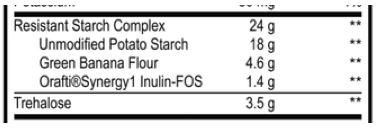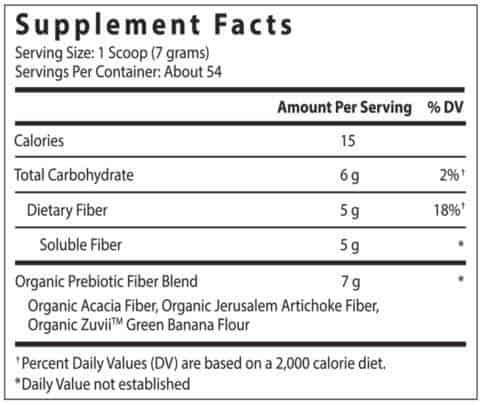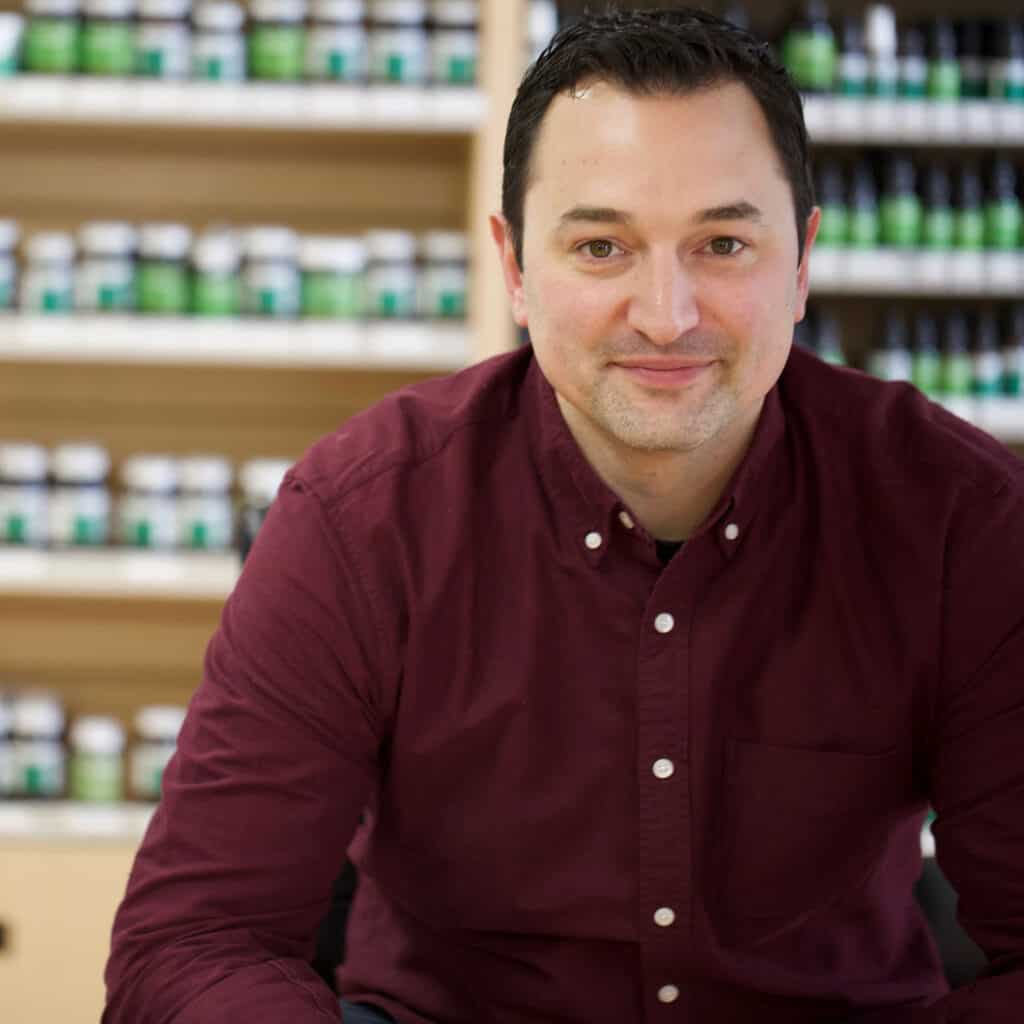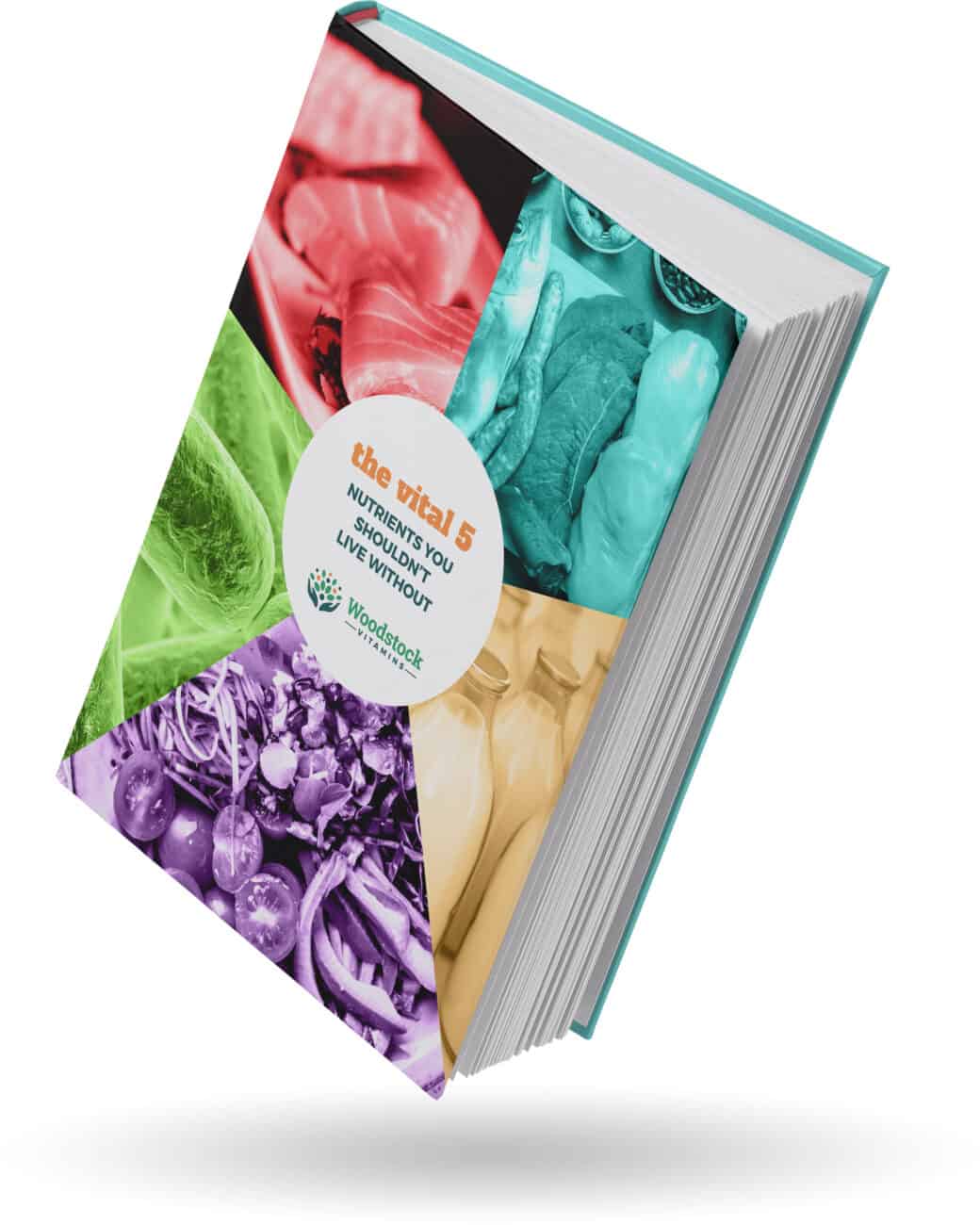Everyone is talking about Prebiotics these days. It’s a new, hot trend within the supplement industry. Even though I am a big gut health nerd, I must admit that I was quite skeptical of prebiotics- because trends in the supplement industry don’t usually have any substance. I was wrong – the benefits of prebiotics are definitely there, and I want to share that with you!
Our understanding of prebiotics is relatively new. The lead research surrounding their role in our bodies is as new as 1995, which feels like just 5 years ago but it is actually over 20 for those counting at home. After putting some time in researching the topic, I can confidently say that prebiotics, while definitely a fad within the industry, carry some real potential.
Let’s get informed about prebiotics, how they compare to probiotics, and help arm ourselves with the proper information to make better decisions about buying or using prebiotics. As you may have guessed, the supplement industry is circling like vultures on this one.
What Are Prebiotics?
Let’s start with what we already know. PRObiotics are supplements that contain specific types of bacteria and are used to help reinforce our gut normal flora – the healthy, helpful bacteria and other microorganisms in our gut. PREbiotics, simply put, are food for those probiotics. Prebiotics is honestly kind of a silly name. A more apt name would be “Probiotic Food”, but even better, it would be “Bug Food.” I’ll stick to writing and stay away from marketing.
A prebiotic is something we eat that, in turn, feeds bacteria and other microorganisms in our gut, helping them to thrive.
To help better understand, let’s talk about my belly fat.
I’ve got some belly fat. Maybe you do too. It is where our body stores excess energy. My body stores excess energy as fat and deposits them around my face and midsection. If I were to skip a meal, however unlikely that is, my body would use the fat as a temporary energy source. It allows me to get through the ebbs and flows of food scarcity as a hunter-gatherer (HA!).
Plants have belly fat too, except it doesn’t hang out over their stems or make it hard to tie their shoes. Plants store their energy in a compound called inulin. If they don’t get enough nutrients, they pull their energy stores from the inulin and can survive, if not temporarily, through harsh conditions.
Inulin is found in over 36,000 plants and is not digested or used by humans when we eat plants. What a waste of energy, right? Well, our smart normal flora, having evolved with us over millennia, won’t let a good snack go to waste. The microbes of the gut will make quick use of inulin as a potent food source.
When you hear the term prebiotic, think dietary fiber. Dietary fiber isn’t digestible so it stays in our guts and acts as roughage, helping bulk up our stools and ensuring regular, healthy bowel movements. These dietary fibers, we now know, contain a main source of energy and food for the microorganisms in our gut, called inulin. A very important point to mention is that we technically don’t need to supplement with prebiotics. A well-balanced diet with enough fruits and vegetables will provide ample prebiotics.
Here are some examples of sources of prebiotics you would find in our diets:
- Whole Grains
- Beans
- Fruits
- Vegetables
- Chia
- Flax
These foods are sources of prebiotics, yes, but they aren’t “rich” in prebiotics. For example, you would have to eat about 1 ½ pounds of bananas to get enough prebiotics for a day. This is meeting your daily requirements for dietary fiber and varying the sources is crucial.
There are, however, some foods that have abundant amounts of prebiotics:
- Gum Arabic (85% prebiotic)
- Chicory Root (64%)
- Jerusalem Artichoke (31.5%)
These ingredients are typically the source for most prebiotic supplements. Before we get into that and discuss how bad the supplement industry is trying to rip people off, let’s talk about how exactly prebiotics work.
What Do Prebiotics Do?
There are a couple analogies I can use to help you understand what the mechanism of prebiotics are in the body. My belly is one – I hope you enjoyed it. Detroit is the other.
Think of your gut as real estate. Many people use a garden analogy, but I want to be different. There are forces that will dictate the quality of the neighborhood that is your gut. To make it successful, we’d like to have great neighbors and a strong police force. The good neighbors will take up space that seedy characters would occupy. The police will keep bad guys at bay. If we stop introducing these good neighbors or cops, the tide swings. Your gut is now downtown Detroit (no offense Detroit – we are rooting for you!).
PRObiotics are the good neighbors and cops your gut needs. Because it is constantly under attack – via medicine, supplements, or emotional and nutritional stress – the good neighbors and cops can be in short supply. Taking well-made probiotics daily ensures that no matter what, a constant supply of good bacteria is being introduced.
PREbiotics, then, is the infrastructure. It’s a healthy budget. Prebiotics are the community boosters. Prebiotics are the neighborhood watch. Prebiotics help the good neighbors and police of your gut thrive, making the neighborhood stronger with less effort.
Getting deeper into the science of it all, there are two main groups of prebiotic compounds. The first is the plant belly fat, inulin, which has a common derivative people may know called FOS. The second is galactooligosaccharides (galacto-oligo-saccharides), or GOS. These come from milk sugars, primarily, but can come from plants and microbes.
The Problem With Prebiotics
Inulin and FOS are effective prebiotics. They improve the concentrations of the two main groups of healthy gut bacteria, Lactobacillus and Bifidobacteria. Unfortunately, inulin and FOS have two BIG liabilities. First, they also feed bad bacteria, in particular opportunistic and disease-causing bacteria such as Klebsiella, Clostridia (think C. diff), and E. coli. This makes sense as these bad guys are also a part of the normal flora and have evolved the same affinity towards the energy from dietary fiber. We just don’t want them to be able to thrive; one false move and they can take over. You can’t shake off an E. coli or C. diff infection easily, it often results in emergent medical care or hospitalization.
Second, and more common, is that inulin and FOS are fermented by the bacteria, creating gas as a byproduct, which leads to bloating, gas, and severe pain. This is NOT good for people with gut issues to begin with.
GOS-based prebiotics don’t carry that same liability. In fact, GOS-based prebiotics are used in things like baby formula, for example, since it helps prevent the gut issues formula can cause, such as hard, infrequent stools and bloating and pain.
Because of this, we recommend GOS-based prebiotics almost exclusively. One, in particular, is arabinogalactan (ara-bino-galactan). Arabinogalactan is an efficient prebiotic – it feeds good bacteria, especially Bifidobacteria, helping them thrive. Unlike inulin, it does NOT feed Clostridia, E. coli, or Klebsiella organisms, nor does it cause gas or abdominal discomfort. In some studies, it has been shown to reduce the numbers of the baddies, even in the presence of inulin from a fiber-rich diet.
Understanding Prebiotic Supplements
Say you want to use prebiotics to best support your gut health. It is a wonderful idea, backed by actual science. Go figure!
We have to now be aware of some tricksy stuff prebiotic supplements try to pull. I did a lot of product comparisons for this blog, and there is a big mess out there in prebiotic land.
What we want is an affordable, concentrated amount of prebiotic compounds like inulin, FOS, or GOS. What most prebiotics give us are expensive, low-concentrations of prebiotic compounds mixed with dietary fibers.
“When you hear the term prebiotic, think dietary fiber.” -Me, a few paragraphs back
Most Americans don’t get nearly enough dietary fiber throughout the day. Men need about 40 grams daily, and women need close to 25 grams. The truth is, we average only 14 grams. It’s crucial that we understand the importance of eating varied complex carbohydrates. If you haven’t already, check out Eat to Fuel Your Fire to learn why.
People report feeling great within DAYS of taking a prebiotic supplement. Prebiotics themselves will take up to a few weeks to feed the bacteria and produce changes in the gut. The immediate impact is from the added fiber found in most prebiotic supplements. If you are so far below the RDA on fiber, eating more or supplementing will make people with GI issues feel much better.
If you’re not getting enough dietary fiber, you should eat more. If it is truly difficult for you to get dietary fiber, then take one of the many different, inexpensive dietary fiber supplements on the market and use it to help reach your daily intake goals.
What you SHOULDN’T do is overpay for a prebiotic that is a glorified fiber supplement.
Case in point:

This product is pretending to be smarter than it is. This product is giving you 1.4g of inulin, which is great (if you want inulin – you don’t!). The other ingredients though are excessive. The banana flour, for example, is just a fiber filler. Doing some quick math, it would take 600 g of banana flour to get enough prebiotic, and this formula has 4.6 g. They put in 150 times LESS than what we need. This is a VERY expensive inulin supplement with cheap, dilute starches added to give the illusion of a sophisticated formula. The dietary fibers are high, but the price of $45 is nowhere near justified.
Here’s a more affordable prebiotic supplement:

This has a more reasonable cost of $26 per bottle. We can’t speak to the quality of the product, but I wouldn’t be hardcore opposed to someone using this. The problem is that the amount of prebiotic compounds is NOT labeled. We know those ingredients (minus the banana flour) are rich in prebiotics, we can’t be certain how much we are actually getting in here. More deception.
Finally, here’s the number one selling prebiotic supplement on the market:

Looking at the product, it looks like a typical prebiotic. In fact, it’s not far off from the $26 bottle we just discussed.
It uses acacia, inulin, flax, some GOS, and guar gum. All things containing or rich in prebiotics. Not knowing manufacturing processes and taking it at face value, this is an OK prebiotic. We don’t know how much of each prebiotic ingredient is in there, but it does contain some GOS. We don’t like inulin because of the liabilities, but as we’ve said, people deficient in fiber who are looking for a prebiotic will meet their goals with this product.
The problem is that this product is priced at $80 per bottle. Shockingly, even at that price point, it is the number one seller in the space. These ingredients do NOT justify this price. This product can be replicated for $30. That pricing is obscene, plain and simple.
If you take the $80 prebiotic, we can find you a substitute that will be less than half the price.
No well made dietary fiber and prebiotic supplement should be more than $50 per bottle, which is typically more than enough for 30 days.
Do Prebiotics Work?
Let’s start with the big one first. Some of the most conservative sources I reviewed mentioned the benefit of a diet rich in prebiotics is beneficial. They even went as far as citing evidence of immune system modulation and improvement. Does this mean you’ll be sick less? Probably not. Your immune system is a big network of systems. The immune support we are discussing is in one facet of the whole thing, but it is a great sign.
This concept makes sense as a majority of our immune system is found in or around our GI tract. Let’s agree that if it TRULY does do this, it is an added perk.
Let’s set our expectations a little lower. Prebiotics help feed good bacteria. Some prebiotics can “starve out” opportunistic microbes. This is an amazing thing.
Helping feed good bacteria will have numerous impacts, probably including keeping your immune system in that sweet spot of efficiency. Let’s just focus on the impact of the gut. Prebiotics, along with fluids and probiotics, help support the gut – making it an even healthier environment. Top value real estate, if I must say.
Good bacteria are called good guys for a reason. They won’t infect us, they help us digest things, they enhance mineral absorption, and they help regulate bowel movements.
Prebiotics feed the good bacteria. This will be a good thing, no matter who you are. Just don’t take prebiotics thinking you won’t get sick or you’ll be able to work at the CDC without one of those hazmat suits.
On a final note with prebiotics, I’m interested in research surrounding prebiotic use in people with inflammatory bowel disease such as colitis or Crohn’s. Dietary prebiotics may specifically help produce anti-inflammatory components that decrease symptoms. Guarner F (2005). “Inulin and oligofructose: impact on intestinal diseases and disorders”. Br J Nutr. 93 (Suppl 1): S61–5. doi:10.1079/BJN20041345. PMID 15877897.
Our Expanded Gut Health Recommendations
Now that we are on board the S.S. Prebiotic, let’s update our gut health recommendations.
- Drink lots of fluids.
- Eat enough dietary fiber (supplement with an inexpensive fiber supplement if need be)
- Take a well made, general gut support probiotic
- Take a concentrated, GOS based prebiotic
While the prebiotic isn’t 100% necessary in someone who has a healthy, normal gut AND gets lots of varied dietary fibers, we feel the benefits of arabinogalactan against the bad bacteria are strong. In those who have GI disease (ulcerative colitis or Crohn’s), the research is in your favor. Definitely talk to your GI doctor and get their read on the whole thing, or even share this article with them!
If you decide you want to try prebiotics, we recommend avoiding inulin or FOS and instead use arabinogalactan. Our own arabinogalactan formula Prebio Complete supports proper immune system function and promotes the growth of probiotic bacteria such as Lactobacilli and Bifidobacteria in the intestines
We also have a formulation called GI Immune Plus. It contains our favorite prebiotic, arabinogalactan, but it adds an immune support compound called IgY. It’s a pretty sophisticated product to support GI health. Think of it as a super prebiotic formula.
How Much Do I Take?
Before we wrap this up, we should probably discuss the proper dosing of prebiotic supplements. To be honest, dosing seems to be all over the place. We researched a few different clinical trials and have come up with this general approach:
- Inulin – around 5-20 grams daily
- Arabinogalactin – about 1-5 grams daily
Remember, inulin is coming from our fiber intake already, so supplementation may not need to be in the 20 grams a day range.
Check with your GI doctor for their recommendation. Start with a single serving found in most supplements, which is usually equal to 1 gram of either inulin/FOS or arabinogalactan. Then, slowly increase as directed by your trusted expert.
The Best Gut Real Estate In The Country
Prebiotics are certainly a hot trend in supplements these days. The supplement industry is quick to produce misleading products and charge a premium for them. Don’t spend lots of money on them.
Instead, really think about your health goals, then decide if a prebiotic is right for you. Do you need more fiber? Do you already take a probiotic? Are you adequately hydrated? Do you have gut discomfort? Are you looking to just have the healthiest gut real estate around?
If you are already checking off those important, foundational first few steps off in our gut health recommendations, a well-made, cost-effective prebiotic supplement may be right up your alley.
Just trying to keep it real…

Neal Smoller, PharmD
Owner, Pharmacist, Big Mouth



